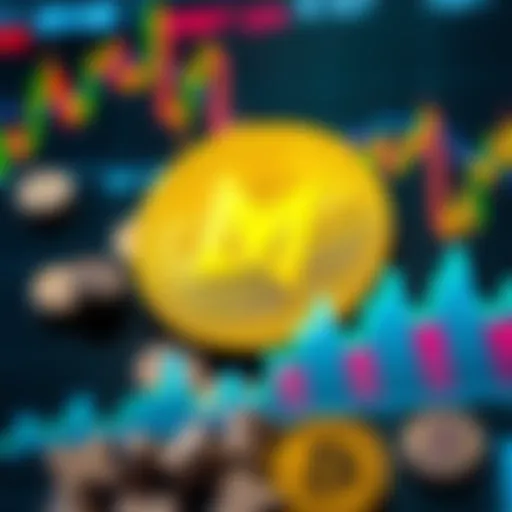Understanding CoinSwap Exchanges: A Detailed Overview


Intro
In the dynamic landscape of cryptocurrency, where innovation meets speculation, understanding the tools and methodologies that underpin trading is crucial. One such tool gaining traction is the CoinSwap exchange, a relatively new player promising anonymity and efficiency. This guide aims to unravel the complexities of these exchanges, shedding light on their operational frameworks while addressing the inherent security nuances and possible hazards.
Utilizing CoinSwap exchanges can be both inviting and daunting for newcomers, alongside seasoned traders looking to broaden their toolkit. Whether you’re hopping on the crypto bandwagon or are already on your way, it’s essential to grasp the fundamental concepts of cryptocurrency, especially as the digital financial world continues to evolve rapidly.
Cryptocurrency Fundamentals
Understanding Blockchain Technology
To comprehend CoinSwap exchanges, one must first appreciate the technology that propels them: blockchain. At its core, a blockchain is a distributed ledger technology that records transactions across multiple computers. This decentralized method enhances transparency and security, making it difficult for any one party to alter the data. Think of it as a digital ledger that anyone can view but only a few can amend, ensuring integrity.
Here are some key characteristics of blockchain technology:
- Decentralization – No central authority controls the blockchain, reducing the risk of single points of failure.
- Immutability – Once recorded, transactions cannot be altered or deleted without consensus among stakeholders.
- Transparency – All transactions are publicly visible, fostering trust within the network.
Understanding these principles is fundamental, as they lay the groundwork for how CoinSwap exchanges operate and why they have emerged as an enticing method for trading cryptocurrencies.
Key Concepts in Cryptocurrency Trading
Navigating CoinSwap exchanges requires familiarity with several key concepts integral to cryptocurrency trading. Here’s a breakdown:
- Peer-to-Peer Trading (P2P): CoinSwaps allow users to engage in P2P trading without intermediaries, which can lower fees and enhance privacy.
- Liquidity: This refers to how easily a cryptocurrency can be bought or sold without affecting its price. High liquidity often means faster transactions and minimal price discrepancies.
- Market Pairs: In the context of CoinSwap exchanges, understanding how different cryptocurrencies trade against one another (like Bitcoin against Ethereum) is crucial for effective trading strategies.
Collectively, these concepts inform trading decisions, help manage risks, and enhance overall trading ability within the sphere of CoinSwap exchanges.
Prelims to CoinSwap Exchanges
CoinSwap exchanges are ushering a new chapter in the cryptocurrency trading space, bridging the gap between traditional finance and decentralized finance. As the world gets more digital, understanding how these platforms operate becomes pivotal not only for investors but also for anyone interested in the emerging trends in finance. These exchanges present an avenue for individuals to trade cryptocurrencies without having to navigate the complexities of centralized platforms, thus enabling a more direct interaction with the digital assets themselves.
Defining CoinSwap Exchanges
At its core, CoinSwap exchanges are platforms that facilitate the swapping of one cryptocurrency for another directly between users. Unlike centralized exchanges that hold user funds in custodial wallets, CoinSwap exchanges pride themselves on enhancing user control and anonymity. The essence of these platforms lies in a decentralized infrastructure powered by blockchain technology, which eliminates the middleman.
For instance, consider a user who wants to convert Bitcoin to Ethereum. On a CoinSwap exchange, this individual can perform the swap directly without registering on a full-fledged exchange, ideally protecting their privacy and reducing the risk associated with hosting funds on a centralized platform. It’s almost like having a conversation directly between two friends to trade items instead of going through a shopkeeper.
The Evolution of Exchange Platforms
The landscape of cryptocurrency exchanges has dramatically transformed since Bitcoin’s inception. In the early days, users primarily relied on centralized platforms like Mt. Gox. However, the infamous collapse of Mt. Gox due to security vulnerabilities turned the tide towards decentralized alternatives. Today's CoinSwap exchanges represent the natural evolution in response to escalating concerns over user control, privacy, and security.
The journey from the likes of Mt. Gox to decentralized finance (DeFi) platforms showcases significant innovations in how traders execute transactions. Initially, platforms focused on user engagement through incentives, which often resulted in compromised security. As a community, awareness grew around the need for safer trading methods, galvanizing the growth of decentralized platforms.
With each iteration, exchanges have adopted advanced technologies such as automated market makers (AMMs) and liquidity pools, empowering users to swap assets without reliance on traditional order books. The trend of utilizing smart contracts has also emerged, enabling seamless and trustless transactions.
In summary, both the operational mechanics and user experience of exchanges have vastly improved. CoinSwap exchanges now represent a robust alternative marrying decentralization with efficiency, setting a precedent for the future of digital asset trading.
Mechanics of CoinSwap Exchanges
Understanding the mechanics of CoinSwap exchanges is key for anyone venturing into the world of cryptocurrency. These platforms rely on innovative technologies and specific processes that facilitate the trading of digital assets with relative ease and efficiency. Grasping these mechanics allows investors and traders to recognize the advantages and pitfalls that come with using CoinSwap exchanges, ultimately enhancing their trading experience.
Foundational Technologies
Blockchain Fundamentals
Blockchain technology is the backbone of CoinSwap exchanges. It's like a digital ledger that records transactions across many computers without allowing alterations to past records. What sets blockchain apart is its transparency and security features. Every transaction is time-stamped and linked to previous ones, forming a chain that remains immutable. This characteristic ensures trust among users since they can verify any transaction independently. In the context of CoinSwap, blockchain enables a decentralized environment where trades can occur directly between users without the need for a central authority. This not only reduces reliance on intermediaries but also minimizes costs. However, its distributed nature can lead to scalability issues, which could hinder transaction speed during peak trading times.
"The transparency that blockchain offers is a game changer in bridging trust gaps in financial exchanges."


Smart Contracts in CoinSwap
Smart contracts are self-executing contracts with the terms of the agreement written into code. Within CoinSwap exchanges, these contracts automate trades and enforce the rules, thus reducing the need for manual intervention. This saves time and increases the overall reliability of transactions. A key characteristic of smart contracts is their ability to execute without human oversight, which significantly reduces the chance of fraud. Nevertheless, while they promise efficiency, mistakes in coding can lead to unintended consequences, such as bugs that might compromise funds. Therefore, while they introduce a layer of automation and security, the diligence in their development cannot be overstated.
Transaction Processes
Order Matching
The order matching process is fundamental to ensuring that buy and sell orders align on CoinSwap exchanges. It operates like a matchmaker for traders. The system compares outstanding orders, finding pairs that can be executed at mutually acceptable prices. This capability is crucial for maintaining liquidity in the market. The beauty of order matching lies in its ability to match orders quickly, allowing traders to seize opportunities as they arise. At the same time, inefficiencies can surface if a sudden influx of orders overwhelms the system, leading to delays in execution and potential lost profits.
Settlement Procedures
Settlement procedures are the final piece of the puzzle in the trading process. After an order is matched and executed, the settlement procedure ensures the exchange of assets and confirms that the correct amounts are transferred between wallets. This aspect is vital as it validates the entire transaction, providing the necessary assurance that both parties fulfill their obligations. A robust settlement process not only upholds the integrity of the exchange but also enhances user confidence. However, potential delays can arise from network congestion or other technical glitches, which can frustrate users eager to finalize their trades.
Advantages of Using CoinSwap Exchanges
When it comes to trading cryptocurrencies, CoinSwap exchanges stand out for several reasons. Understanding these advantages is vital for investors and traders who seek to optimize their trading experience. The unique nature of CoinSwap exchanges offers a suite of benefits that traditional exchanges may struggle to provide. Let's explore these advantages in detail below.
Enhanced Liquidity
One of the most significant benefits of CoinSwap exchanges is the enhanced liquidity they offer. Liquidity in trading refers to how easily an asset can be bought or sold in the market without affecting its price. In the context of CoinSwap, multiple liquidity pools enable users to swap assets quickly and efficiently.
By engaging with decentralized liquidity, traders can often find their desired trading pairs without waiting long for transactions to complete. The pooling mechanisms allow for larger sums of currency to transition seamlessly between users. This reduces slippage—a concern for traders regarding the difference between the expected price of a trade and the actual transaction price.
Furthermore, liquidity on CoinSwap exchanges often comes from a broader range of sources than centralized exchanges. This variety in liquidity sources helps in stabilizing price adjustments during market shifts. With higher liquidity, investors can take larger positions without concerns of significant price movements against them.
User Privacy and Anonymity
In an age where data privacy is a key concern, CoinSwap exchanges provide robust solutions for maintaining user anonymity. Unlike traditional exchanges that often require extensive personal information, CoinSwap platforms typically allow users to trade without the need to disclose sensitive data.
This privacy-centric approach has implications for freedom in financial transactions, especially in regions where strict regulations may hinder individuals from accessing digital currencies. The decentralized nature of these exchanges ensures that trades can occur without the overreach of regulatory bodies, thus promoting an atmosphere of trust among users.
A noteworthy advantage is also the use of non-custodial wallets, which means that users retain complete control over their private keys. This combination of privacy and control encourages broader participation from users who are hesitant to engage with centralized services. With CoinSwap, users can conduct transactions more securely, retaining anonymity as a fundamental right.
Reduced Transaction Costs
Cost is a pivotal element to consider for anyone exchanging cryptocurrencies. CoinSwap exchanges often present a more favorable landscape for those looking to minimize transaction costs. Traditional platforms charge various fees—trading fees, withdrawal fees, and others—that can accumulate significantly over time.
In contrast, CoinSwap exchanges primarily function on a peer-to-peer basis, cutting out the intermediaries that usually markup costs. This can lead to lower fees or even fee-less transactions in some instances. For example, users can swap assets directly with minimal network fees, particularly notable when using token standards like ERC-20 and BEP-20 in their respective ecosystems.
This cost efficiency becomes especially potent for frequent traders who make numerous transactions regularly. Even small savings per trade can amass into substantial amounts over time, enhancing profitability.
Low transaction costs combined with greater privacy features can fundamentally change how trades are executed, pushing the envelope of what's possible in cryptocurrency trading.
In summary, the advantages of using CoinSwap exchanges are manifold, focusing on liquidity, privacy, and cost-efficiency. As more users become aware of these benefits, the trend towards decentralized trading platforms like CoinSwap is likely to accelerate, shaping the future landscape of cryptocurrency trading significantly.
Challenges in CoinSwap Exchanges
The world of CoinSwap exchanges, while promising, is riddled with challenges that require careful consideration by traders and investors alike. As users seek to capitalize on the benefits of these platforms, understanding the weighty issues they face can not only safeguard assets but also improve the experience overall. The significance of discussing these challenges lies in shining a light on potential pitfalls, enabling users to navigate the landscape more adeptly.
Security Risks and Vulnerabilities
Hacking Incidents
Hacking incidents pose a significant threat to the integrity of CoinSwap exchanges, often compromising user funds and eroding trust in the cryptocurrency ecosystem. These breaches typically stem from vulnerabilities within the exchange's infrastructure, such as outdated software, insecure APIs, or weak authentication protocols. It's a recurring theme in cryptocurrency, where hackers are always working a step ahead to exploit security loopholes.
A prime example was the infamous "Bitfinex hack" in 2016, where attackers made off with nearly 120,000 Bitcoin, a loss that sent shockwaves through the trading community. These hacking incidents highlight the importance of robust cybersecurity measures. While no platform can claim to be entirely impervious, those that invest in advanced security features can attract those wary of the risks.


Advantages of Addressing Hacking Risks:
- Enhanced trust among users
- Improved platform reputation
- Increased user base as security measures bolster confidence
Smart Contract Flaws
Smart contracts are pivotal in the operation of CoinSwap exchanges, dictating the terms of trade and executing transactions without intermediaries. However, they are not without their flaws. The oversight or bugs in the code can lead to catastrophic failures, including the freezing of funds or even unintentional losses. The infamous "DAO hack" of 2016 serves as a case in point, where an exploit of a smart contract flaw led to a massive theft of Ether.
This facet of CoinSwap exchanges emphasizes the need for rigorous testing and audits. While many platforms now engage third-party security firms to scrutinize their contracts, the inherent complexity in coding means there’s always a margin for error.
Considerations Regarding Smart Contract Flaws:
- Continuous auditing and updates are necessary
- Community feedback can aid in spotting issues
- Transparent communication helps users understand risks
Regulatory Compliance Issues
As CoinSwap exchanges operate across various jurisdictions, regulatory compliance becomes a complex endeavor. Regulations can fluctuate significantly between regions, with some governments adopting a more lenient approach than others. Those that fail to adhere to these regulations risk facing hefty fines or, worse, being shut down entirely.
Challenges include:
- Varied international laws: What may be legal in one country can be illegal in another, complicating operations.
- Evolving regulations: As governments adapt to the crypto landscape, exchanges must stay agile in their compliance measures.
- Consumer protection laws: Investors are more likely to engage with exchanges that take legal responsibilities seriously, fostering a safer trading environment for everyone.
Market Volatility Concerns
Markets are notoriously fickle in the cryptocurrency space, and CoinSwap exchanges are no exception. Investments can swing wildly due to factors like market sentiment, global economic indicators, or even social media trends. This volatility can create both opportunities and fears among users.
The challenges of market volatility include:
- Rapid price fluctuations: Traders need to constantly monitor the market to avoid unexpected losses.
- Psychological impacts: Investors may feel pressured to make hasty decisions based on market panic or euphoria, leading to poor choices.
The volatility isn't just a headache; it's part of the thrill for seasoned traders who are adept in managing risks. However, adequate education and risk management strategies are vital for anyone engaging with CoinSwap exchanges, particularly novices venturing into crypto trading for the first time.
Use Cases for CoinSwap Exchanges
CoinSwap exchanges bring about a plethora of opportunities within the cryptocurrency realm. Understanding their use cases is pivotal for investors, traders, and tech enthusiasts. These exchanges drive innovation, enhance liquidity, and provide avenues for diverse financial strategies and applications. As the cryptocurrency landscape evolves, it's vital to grasp how CoinSwap exchanges can be harnessed effectively.
Trading Strategies
Arbitrage Opportunities
Arbitrage involves taking advantage of price discrepancies across different exchanges. It’s a vital strategy that attracts traders looking to make quick profits with minimal risk. Imagine spotting the same asset priced lower on one platform than another - this is where the real magic happens. CoinSwap exchanges often facilitate rapid transactions, making them a perfect fit for this strategy.
Key characteristic: The speed at which trades can be executed on CoinSwap platforms adds to their allure. Traders can hop between exchanges with ease, executing trades almost instantaneously.
Benefits: The essential part of arbitrage opportunities lies in its relatively low risk, as traders often exploit predictable market inefficiencies. However, it doesn’t come without its caveats. The returns can be thin, requiring substantial capital and quick execution to make profits worthwhile. Plus, transaction fees might eat into earnings if you’re not careful.
"Arbitrage trading is like catching a falling knife; timing is everything."
Speculative Investments
Speculative investments present a more nuanced approach. They hinge on predicting future price movements and can yield high rewards if done correctly. Traders using CoinSwap exchanges can trade various cryptocurrencies, making it easier to enter and exit positions based on market sentiment.
Key characteristic: The volatility that surrounds cryptocurrencies is the bread and butter for many speculative investors. They thrive on fluctuations and leverage tools available in CoinSwap exchanges to maximize gains.
Unique feature: Speculative investments allow for opportunities such as leverage trading, where you can trade with borrowed funds. However, this comes with heightened risk as losses can be amplified. Balancing risk and rewarding potential is essential for those venturing into this territory.
Decentralized Finance (DeFi) Applications


The rise of decentralized finance (DeFi) has altered traditional perspectives on financial systems. CoinSwap exchanges play a crucial role in this wave, allowing users to engage directly with financial instruments without intermediaries. From lending and borrowing to earning interest on holdings, the applications are vast. Users can interact with various DeFi protocols by utilizing CoinSwap exchanges for seamless transactions.
One primary advantage of DeFi on CoinSwap platforms is the democratic structure it offers. This empowers a broader audience, allowing access to financial services irrespective of geographical barriers. Through these platforms, users can participate in liquidity pools or yield farming, potentially earning rewards progressively.
Non-Fungible Tokens (NFTs) and CoinSwap
The integration of NFTs presents another intriguing facet of CoinSwap exchanges. As these unique digital assets continue to gain popularity, the ability to swap them easily becomes paramount. CoinSwap platforms that accommodate NFT swapping can facilitate a dynamic marketplace, enabling collectors and creators to trade without intermediaries.
Pros: This interoperability nourishes a more vibrant ecosystem, allowing for seamless transitions from one asset class to another. However, the NFTs’ distinctive nature brings challenges, such as valuing the assets accurately during swaps. If an asset is overvalued, it can lead to dissatisfaction for both parties involved. Therefore, understanding the underlying value becomes crucial.
Future of CoinSwap Exchanges
The future of CoinSwap exchanges stands as a pivotal concern for investors and traders alike, as it embarks on a journey towards new dimensions of decentralization and technological advancement. This section sheds light on anticipated innovations and trends that promise to reshape the landscape of cryptocurrency trading and liquidity. While challenges will inevitably arise, the potential benefits such as improved efficiency, interoperability, and user engagement cannot be overlooked. Exploring these aspects equips participants in the market with a clearer understanding of what lies ahead and how they can navigate this evolving terrain.
Technological Innovations on the Horizon
Layer Two Solutions
Layer Two solutions serve as a beacon of hope for enhancing transaction speeds and scalability within CoinSwap exchanges. These protocols, which build on top of existing blockchains, aim to solve significant issues related to network congestion and transaction fees. One key characteristic of these solutions is their ability to process transactions off-chain, thus alleviating strain on the main blockchain. This can lead to a much smoother trading experience.
One of the standout features of Layer Two is its potential for rapid confirmation times, which can significantly enhance user experience during periods of high market activity. This helps to sidestep the bottleneck associated with on-chain transactions. However, despite these advantages, there are considerations to keep in mind, such as potential hurdles related to liquidity that may arise when employing off-chain mechanisms.
Cross-Chain Interoperability
Cross-Chain interoperability highlights another transformative aspect slated to impact CoinSwap exchanges. This feature aims to facilitate seamless transactions across different blockchain networks. With cryptocurrencies no longer confined to their originating chains, traders and investors can interact with multiple ecosystems without hassle. The key benefit here is the enhanced liquidity created by enabling assets to flow freely across platforms.
An intriguing aspect of cross-chain interoperability is its ability to promote inclusivity within the crypto market. By allowing users to explore various decentralized applications and assets from different chains, it expands trading options exponentially. Nonetheless, challenges remain like security concerns and varying consensus mechanisms across chains that need addressing to unleash its full potential in the CoinSwap framework.
Market Trends and Predictions
As the CoinSwap exchanges evolve, understanding market trends becomes crucial for stakeholders. Predictions during this transition point suggest an increasing shift towards decentralized finance (DeFi) principles, where user autonomy and ownership dominate. The demand for greater privacy and data security among users is unlikely to wane.
Key market trends to watch include:
- An upsurge in decentralized applications (dApps) leveraging CoinSwap functionalities.
- Progress toward more robust regulatory frameworks that will impact the operational landscape.
- Heightened focus on user education and empowerment to reduce information asymmetry.
By keeping an eye on these developments, investors can better position themselves to capitalize on future opportunities within the CoinSwap exchange ecosystem.
"The evolution of CoinSwap exchanges will undoubtedly introduce both possibilities and challenges, yet it creates an environment ripe for innovation and new engagements among traders and investors."
Overall, the future trajectory of CoinSwap exchanges is compelling, driven by technological advancements and the shifting dynamics of market participation.
Epilogue
The conclusion of this exploration into CoinSwap exchanges serves as a pivotal wrap-up, highlighting the salient aspects discussed throughout the article. As we've traversed the intricate workings, advantages, challenges, and the future landscape of these exchanges, the overarching importance lies in their impact on cryptocurrency trading. CoinSwap exchanges introduce notable benefits like privacy, reduced costs, and robust liquidity that can significantly enhance a user’s trading experience. However, amidst these perks, it's crucial to keep an eye on potential risks, such as security vulnerabilities and regulatory uncertainty.
Summarizing Key Insights
This article has carefully elucidated the foundation and operational framework of CoinSwap exchanges. A few key insights include:
- User Privacy: CoinSwap exchanges can provide enhanced anonymity, a distinct advantage when compared to traditional platforms.
- Liquidity Advantages: These exchanges often allow for quicker transactions and better pricing through broader liquidity pools.
- Transaction Costs: Lower fees make CoinSwaps appealing, particularly for active traders who perform frequent transactions.
- Security Challenges: While promising, users must be wary of hacking incidents and assess the solidity of smart contracts. Inevitably, the realm of CoinSwap exchanges calls for due diligence to mitigate risk.
In integrating these insights, users are better equipped to navigate the complexities of CoinSwap exchanges, making informed decisions in their trading endeavors.
Looking Ahead
As we gaze into the future of CoinSwap exchanges, several trends appear to take shape. Technological advancements are on the horizon, such as:
- Layer Two Solutions: These are geared towards improving transaction speeds and scalability without compromising security, potentially revolutionizing the CoinSwap experience.
- Cross-Chain Interoperability: The ability to conduct transactions seamlessly across different blockchain networks can enhance user accessibility and broaden trading opportunities.
Investors, traders, and tech enthusiasts should keep their ears to the ground regarding these innovations, as they hold the promise of creating a more robust and user-friendly digital currency landscape.
As the environment evolves, so too should understanding and adaptability regarding how one interacts with CoinSwap platforms. A proactive approach can lead to not only smarter trading but also contribute to a more resilient cryptocurrency ecosystem. The essence of progressing in this space relies heavily on being informed and responsive to both market dynamics and technological trends.



